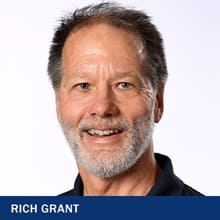Curriculum Vitae (CV) vs. Resume: What's the Difference?

Jobseekers can use a curriculum vitae (CV) or a resume to communicate their education, work experience, skills and qualifications to potential employers.
In the United States, these documents are meant for different audiences. Unlike a resume, which concentrates on communicating your most relevant work experience and education history, a CV is longer, more detailed and can include more personal information relevant to academic and research positions, according to HR Digest.
While you’d submit a resume for most job roles in the U.S., there are some cases where you’ll be required to submit a CV.
What are the Major Differences Between a Resume and a Curriculum Vitae?

“Your resume shouldn't be a compilation of job duty descriptions but should instead serve as a marketing document," said Rich Grant, a business career advisor at Southern New Hampshire University (SNHU) and a certified resume writer. “You should typically only go back 10 to 15 years and emphasize your most relevant experience."
The Latin term “curriculum vitae” literally means "course of life" and summarizes your education, research contributions and teaching experience. If you’re applying for a job at a university, medical facility or research institution, you'd likely be asked to provide your CV instead of a resume, Grant said.
CVs are much longer than resumes, and experienced professionals' CVs could be as long as 10 pages. These documents share many of the same elements as resumes but would also include any research, presentations, publications or teaching experience, according to Grant.
“For the average American jobseeker, a resume is more widely used than a CV,” he said. “If you’re applying to jobs with businesses, nonprofits or the government, a resume is the correct document."
How Do You Format a Resume?
Resumes should be clear, easy to read and provide essential information a potential employer would need to determine whether you're qualified for a role at their organization. The purpose of your resume is to entice a hiring manager to invite you to participate in the next step of their recruiting process, the interview, Grant said.
Key Resume Elements Include:
Contact information – This section should include your full name, city, state, phone number and email address. According to Forbes, there are pros and cons to including your home address. While it may help fulfill applicant tracking system parameters, it can compromise your identity.
- Summary of qualifications – Rather than stating an objective, you should briefly describe your work experience and skills, highlighting the value you’d bring to the company. For example, soft skills, such as "team management skills," should be listed below your professional summary, said Jennifer Brown, a career advisor at SNHU. She recommends listing out no more than nine skills related to the job you're applying for.
- Education – List your college degrees and any professional certifications. According to Monster, if you're a new graduate, you might consider including your graduation year, academic achievements and any coursework that pertains to the job you're seeking. This section would also list academic awards (such as Phi Beta Kappa). However, Brown said most employers aren't interested in seeing your GPA unless you're applying for internships or federal positions.
Certifications – Include special certifications and professional licenses, including teaching, nursing or social work licenses or computer certifications. Additional professional certificates, professional development or training would go at the end of your resume, Brown said.
- Professional work history – The most substantive section of your resume, this is the place where you’d list the jobs you’ve held and your professional experience.
Grant said it's important to show how your accomplishments in other jobs have prepared you to succeed in the role you're applying for. Write action-oriented bullets that show any value you've brought to your previous employers in reverse chronological order, beginning with the job you most recently held.
For example, one bullet might be: "Increased student and employer participation in the internship program by 32% and 25%, respectively, by producing new promotional materials and creating new employer outreach events."
- Technical skills – List any software programs, programming languages or other technical certifications you might have that relate to the new position you’re seeking. For example, if you were applying for a sales job, it might be vital for you to list your proficiency with Salesforce.
- Volunteer Experience – If you have room and it pertains to the job role, your volunteer experience might show your passion and aptitude for a job, particularly if you don't have a lot of work experience, Brown said.
Resume Writing Tips
There are ways you can format your resume to make it easier for recruiters and hiring managers to evaluate, according to Brown:
- Use keywords from the job posting to describe your previous work experiences or skill sets. Some companies use applicant tracking systems (ATS) to screen resumes for particular keywords.
Keywords aren't everything, though, according to Grant. Context around the keywords that demonstrate your knowledge, skills and experiences is necessary to be considered for an interview. "Even the recruiters who use their ATS to help filter out resumes will ultimately read the actual resume before inviting the applicant to interview," Grant said.
- Create your resume in a program that allows you to convert it to a PDF so that an employer's ATS system can read it. If you choose to add graphics, they shouldn't distract from who you are as a professional.
- Read your resume out loud and have someone else proofread it for errors.
- Write your resume in a neutral font (such as Arial or Times New Roman) rather than script fonts or unusual fonts like Comic Sans, for example, and make sure it’s at least 11 pt.
- Create different versions of your resume for various job roles or industries, particularly if you're a career-changer or looking at jobs in two distinct sectors.
While it might seem overwhelming to write a resume, you should avoid having someone else write it for you.
“You know yourself best. I can tell stories about those who relied on resume-writing services and paid hundreds of dollars," Brown said. "The result included grammar and spelling mistakes along with gross inaccuracies."
SNHU Employer Relations Partner Dana McGrath shares more tips on how to write an effective resume.
What Does a CV Look Like?
CVs and resumes share several components; however, they do follow a different format. CVs are more comprehensive and follow a different format. According to Brown, you should use the following outline to organize your academic and professional accomplishments:
Contact information – Include information similar to what you’d include in a resume.
- Desired job title – State the job title for which you are applying.
- Professional profile – This section is similar to a resume's summary of qualifications but should be written as an "elevator pitch" to explain the accomplishments in your CV.
- Education, including research topics – List your college degrees in reverse-chronological order and your GPA, major, minor and research focus.
- Honors and awards – Include any recognition from professional or academic organizations, including any grants you’ve received.
- Qualifications – Similar to a resume, a CV’s summary of qualifications highlights your skills as they relate to the role you are applying for. If you’re applying for an academic job, you could mention your on-site and virtual presentation skills, for example.
- Teaching experience – Highlight the names of any courses you’ve taught, where you taught them, and when.
- Publications and presentations – In a CV, potential employers are interested in your published research and conference presentations. Cite any published works in APA or MLA style, depending on the employer's preferred format.
- Affiliations and memberships – If you’re a part of a professional organization, list any contributions you’ve made as a member or board member.
- Technical skills – As you would in a resume, mention any computer software programs, programming languages or research databases you have proficiency in using.
A CV is a living document you'll need to update as you gain academic or research experience. If you publish new papers or expand your research program, you'll want to note that in your CV.
Whether you’re using a resume or a curriculum vitae to highlight your accomplishments, it's important to take an in-depth inventory of your experience and skills and connect the dots for potential hiring managers. If you’re feeling overwhelmed, you can always seek advice from someone in your field or professional network. Some universities, such as SNHU, can also match you with career advisors familiar with your field who’ve read and provided input on thousands of resumes.
"Writing your resume and working with your career advisor will help you prepare for an interview," Brown said. "Sometimes you know what you want to say, but sometimes your message is not always clear. That second pair of eyes is always beneficial."
A degree can change your life. Choose your program from 200+ SNHU degrees that can take you where you want to go.
Krysten Godfrey Maddocks ’11G is a writer who covers K-12 and higher education topics, including policy and the role of digital technology in education. She spent almost a decade working in various marketing roles at an educational assessment company before launching a strategic marketing company. Maddocks earned a master's degree in marketing from Southern New Hampshire University and a bachelor's degree in English/ journalism from the University of New Hampshire. Connect with her on LinkedIn.
Explore more content like this article

From Application to Offer: 5 Steps on How to Get the Job

The Day 1 Advantage at SNHU: Career Support from the Start

11 Good Reasons for Leaving a Job
About Southern New Hampshire University

SNHU is a nonprofit, accredited university with a mission to make high-quality education more accessible and affordable for everyone.
Founded in 1932, and online since 1995, we’ve helped countless students reach their goals with flexible, career-focused programs. Our 300-acre campus in Manchester, NH is home to over 3,000 students, and we serve over 135,000 students online. Visit our about SNHU page to learn more about our mission, accreditations, leadership team, national recognitions and awards.

